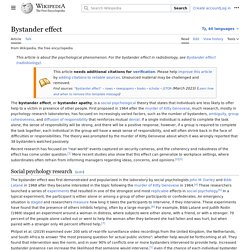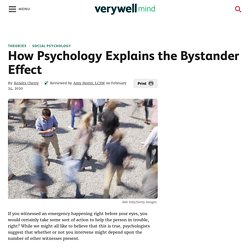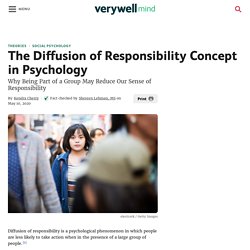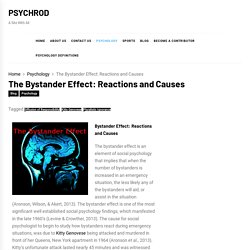

Bystander effect. Social psychological theory Social psychology research[edit] Philpot et al (2019) examined over 200 sets of real-life surveillance video recordings from the United Kingdom, the Netherlands, and South Africa to answer "the most pressing question for actual public victims": whether help would be forthcoming at all.

They found that intervention was the norm, and in over 90% of conflicts one or more bystanders intervened to provide help. Increased bystander presence can increase the likelihood that someone would intervene,[1] even if the chance of each individual bystander responding is reduced. Variables affecting bystanders[edit] Emergency versus non-emergency situations[edit] Latané and Darley performed three experiments to test bystander behavior in non-emergency situations.[6] Their results indicated that the way in which the subjects were asked for help mattered. According to Latané and Darley, there are five characteristics of emergencies that affect bystanders:[6] What Is the Bystander Effect? If you witnessed an emergency happening right before your eyes, you would certainly take some sort of action to help the person in trouble, right?

While we might all like to believe that this is true, psychologists suggest that whether or not you intervene might depend upon the number of other witnesses present. The Bystander Effect and Altruism. Learning Objectives Explain the factors that influence human altruism, including reciprocal altruism and diffusion of responsibility.

Go to YouTube and search for episodes of “Primetime: What Would You Do?” You will find video segments in which apparently innocent individuals are victimized, while onlookers typically fail to intervene. The events are all staged, but they are very real to the bystanders on the scene. We Are All Bystanders. For more than 40 years, Peggy Kirihara has felt guilty about Stewart.

Peggy liked Stewart. They went to high school together. Their fathers were friends, both farmers in California’s Central Valley, and Peggy would always say “hi” when she passed Stewart in the hall. Yet every day when Stewart boarded their school bus, a couple of boys would tease him mercilessly. And every day, Peggy would just sit in her seat, silent. “I was dying inside for him,” she said. Peggy still can’t explain why she didn’t stick up for Stewart. . © Damian King But perhaps most surprising—and distressing—to Peggy is that she considers herself an assertive and moral person, yet those convictions aren’t backed up by her conduct on the bus.
“I think I would say something now, but I don’t know for sure,” she said. Many of us share Peggy’s concern. Why don’t we help in these situations? “Why,” asked Garfield, “do some people respond to these crises while others don’t?” Altruistic inertia Who are these people? © Damian King. Bystander Effect: What Is It and What You Can Do About It.
What the bystander effect looks like A little after 3 a.m. on March 13, 1964, Catherine “Kitty” Genovese parked her car and walked to her apartment in Queens, New York, after finishing her shift as a bar manager. Serial killer Winston Moseley was out to victimize someone that night. Genovese became his target. How Diffusion of Responsibility Affects People. Diffusion of responsibility is a psychological phenomenon in which people are less likely to take action when in the presence of a large group of people.1 For example, imagine that you are in a large city on a bustling street.

You notice a man fall to the ground and start convulsing as if having a seizure. Many people turn and look at the man, but no one moves to help or call for medical assistance. Why? Because there are so many people present, no one person feels pressured to respond. The Bystander Effect: Reactions and Causes - PSYCHROD.
Bystander Effect: Reactions and Causes The bystander effect is an element of social psychology that implies that when the number of bystanders is increased in an emergency situation, the less likely any of the bystanders will aid, or assist in the situation (Aronson, Wilson, & Akert, 2013).

The bystander effect is one of the most significant well established social psychology findings, which manifested in the late 1960’s (Levine & Crowther, 2013). The cause for social psychologist to begin to study how bystanders react during emergency situations, was due to Kitty Genovese being attacked and murdered in front of her Queens, New York apartment in 1964 (Aronson et al., 2013). Kitty’s unfortunate attack lasted nearly 45 minutes and was witnessed by nearly 38 residents who did not assist by calling police, or trying to stop her attacker (Aronson et al., 2013).
I Want to but I Won't: Pluralistic Ignorance Inhibits Intentions to Take Paternity Leave in Japan. Introduction Paternity leave refers to a father's taking a temporary leave of absence from work to care for a newborn.

Parental roles have traditionally been gendered in families with young children; that is, men have been primarily responsible for earning and women for caring. Pluralistic Ignorance. Kitty Genovese. The Kitty Genovese murder in Queens, New York, in 1964 is one of the most famous murder cases to come out of New York City and into the national spotlight.

What propelled it wasn’t the crime or the investigation, but the press coverage that alleged the murder had many witnesses who refused to come to the Kitty Genovese’s defense. This has been disproved over time, but not before it became part of the accepted lore of the crime. Kitty Genovese was returning from work home at around 2:30 a.m. on March 13, 1964, when she was approached by a man with a knife. Genovese ran toward her apartment building front door, and the man grabbed her and stabbed her while she screamed. A neighbor, Robert Mozer, yelled out his window, “Let that girl alone!” THE BYSTANDER EFFECT.
10 Notorious Cases of the Bystander Effect. The 21st century bystander effect happens every day online. If you’re going to fall, injure yourself and need help, where is a good place to do it?

Should you choose a busy thoroughfare or a deserted backstreet? Statistics and experiments in social psychology will tell you that if you need help, you should avoid dropping in a busy street, even if hundreds of people are passing through. How the bystander effect can explain inaction towards global warming. Not too long ago, I was preparing a lecture about group dynamics for my students at Delft University of Technology.

One of the dynamics I wanted to introduce was the bystander effect. The bystander effect refers to the phenomenon that an individual’s likelihood of offering help in a critical situation decreases when passive bystanders are present (e.g., Darley & Latané, 1968). The murder case of Kitty Genovese is considered as the iconic real-life example of the bystander effect. Psychology textbooks all over the world describe how in 1964 a young woman was raped and murdered in New York while dozens of neighbours looked on but did not come into action to help her (e.g., Manning, Levine, & Collins, 2007).
The New York Times reported on their front-page as follows: “For more than half an hour thirty-eight respectable, law-abiding citizens in Queens watched a killer stalk and stab a woman in three separate attacks in Kew Gardens. First, diffusion of responsibility. The Bystander Effect in Emergency Situations. Mental Health The Bystander Effect in Emergency Situations By Karen Doll, Psy.D., L.P. 57f87e561c4d2d65715e6fe94e872b34299e. VanBommelEtAlJESPinpress. Young children show the bystander effect in helping situations. From Empathy to Apathy: The Bystander Effect Revisited - Ruud Hortensius, Beatrice de Gelder, 2018.
When people are asked whether they would spontaneously assist a person in an emergency situation, almost everyone will reply positively. A Summary of the Bystander Effect: Historical Development and Relevance in the Digital Age. This article provides a historical perspective on the bystander effect, a social phenomenon that Darley and Latané first studied experimentally in 1968. Critical events that took place prior to the study of the bystander effect are discussed. Specifically, emphasis is placed on the formation of the Society for the Psychological Study of Social Issues in 1936, Kurt Lewin’s social action research in the late 1930s, and the cognitive revolution of the 1950s.
Brief report: The bystander effect in cyberbullying incidents. Abstract.